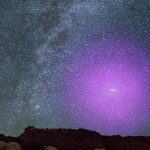

View larger. | Andromeda galaxy actual size? Yes. This image truly depicts what the night sky would look like if the Andromeda galaxy – the galaxy next door – were brighter. Original background shot of the moon by Stephen Rahn. Andromeda galaxy image via NASA. Composite photo by Tom Buckley-Houston. The composite showed up on Reddit a few years ago. Not convinced? Here’s a similar image via APOD.
The image above shows how the neighboring Andromeda galaxy occupies about the width of six moon-diameters on our sky’s dome. But, of course, the galaxy isn’t nearly this bright. You need a dark sky to see it, and, even then, it’s a barely visible fuzzy patch of light. In order to appear as bright as in the image above, the Andromeda galaxy would need to be closer. If it were close enough to look so bright, it would appear even bigger on our sky’s dome. And that’s going to happen someday! The Andromeda galaxy is currently racing toward our Milky Way at a speed of about 70 miles (110 km) per second. Ultimately, the two galaxies will collide and merge.
Normally, the news that the Milky Way and Andromeda are going to collide is not a very headline-causing piece of information, since it is due to take place in about 5 billion years. But, new research published in the peer-reviewed Astrophysical Journal in August this year reveals that the timeline has been revised: The collision has already started!
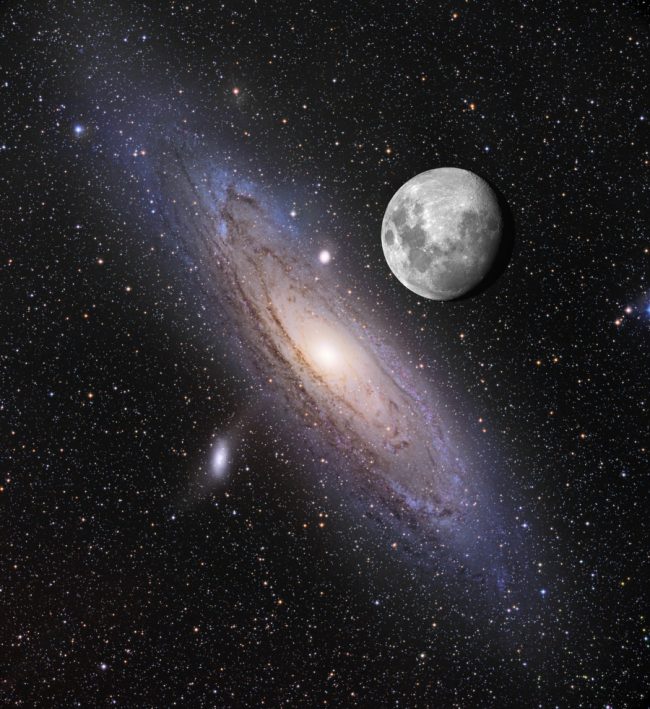
View larger. | Here’s another composite image showing the true size in our sky of the Andromeda galaxy. This one is from astrophotographers Adam Block and Tim Puckett. It was the Astronomy Picture of the Day for August 1, 2013.
That news about the Andromeda galaxy came from Project AMIGA, which uses the Hubble Space Telescope to look at the deep-space surroundings of the Andromeda galaxy. AMIGA stands for Absorption Map of Ionized Gas in Andromeda. NASA reported on this study earlier this year, calling it “the most comprehensive study of a halo surrounding a galaxy.”
The Andromeda galaxy, our Milky Way and other galaxies all sit enshrouded in a large envelope – a so-called galactic halo – which consists of gas, dust and stray stars. The halos of galaxies are faint, so faint that detecting them is not an easy feat. These astronomers measured the size of the halo of the Andromeda galaxy by looking at how light from background quasars had been absorbed by it. They were surprised to find that the Andromeda galaxy’s halo stretches much, much farther out beyond the visible boundaries of the galaxy than previously known.
In fact, it extends as far as half the distance to our Milky Way (1.3 million light-years) and even farther in other directions (up to 2 million light-years).
Does this mean the halos of the Andromeda and Milky Way galaxies are touching?
It turns out that, from our vantage point inside the Milky Way, we cannot easily measure the characteristics of our galaxy’s halo. However, because the two galaxies are so similar in size and appearance, scientists assume that the halo of the Milky Way would also be similar.
In other words, it’s the faint halos of the galaxies that indeed appear to have started to touch one another. Thus, in a manner of speaking, the collision between our two galaxies has already started.
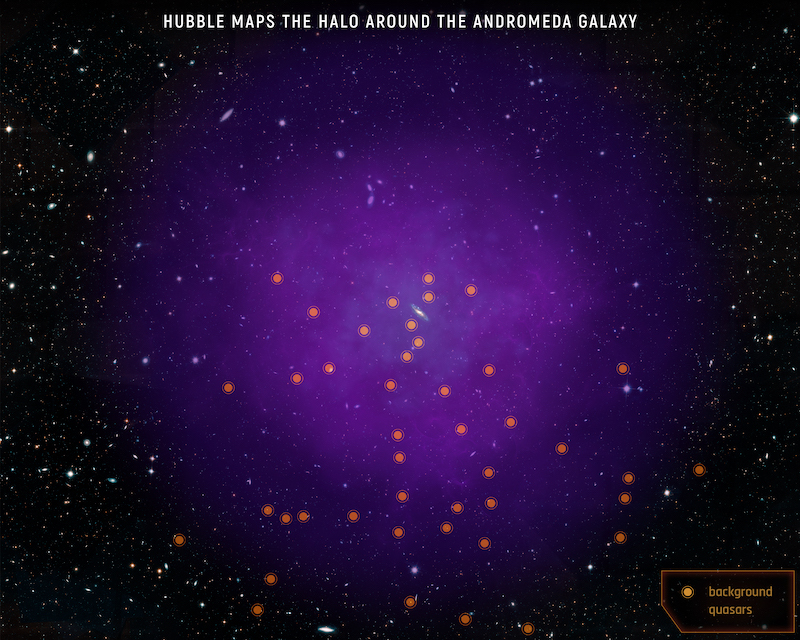
Observing 43 background quasars, scientists used the Hubble Space Telescope to map out the halo of the closest spiral galaxy to our Milky Way, the Andromeda galaxy. The light from these very distant quasars (emission from very bright galaxies fueled by a central supermassive black hole) is absorbed as it travels through the halo, and by studying the change in absorption depending on where in the halo you look, scientists not only see the large extent of the halo but also what it consists of. Illustration via NASA/ ESA/ E. Wheatley (Space Telescope Science Institute)
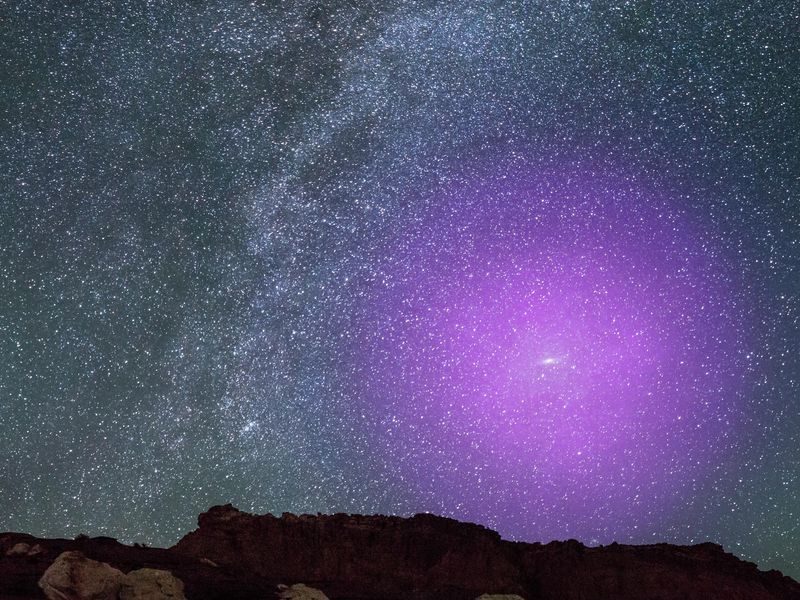
This illustration depicts what the Andromeda galaxy’s gaseous halo might look like if it were visible to humans on Earth. At 3 times the size of the Big Dipper, the halo would be easily the biggest feature on the nighttime sky, according to NASA. Recent measurements of the halo show that the collision between the Milky Way and Andromeda galaxies has already begun. Image via NASA/ ESA/ J. DePasquale and E. Wheatley (STScI)/ Z. Levay.
Not taking the halo in account, the bulk of the Andromeda galaxy is now about 2.5 million light-years away from us, and getting closer all the time. As stated above, as the Andromeda galaxy comes closer, it will appear larger in our sky.
Between now and the eventual merger, any beings alive on Earth will see it get bigger and bigger and BIGGER in our night sky.
The artist’s concepts below, released by NASA in 2012, show what will happen to Earth’s night sky as the Andromeda galaxy hurtles toward us.
The descriptions below are based on painstaking Hubble Space Telescope measurements of the motion of the Andromeda galaxy, followed by computer modeling of the inevitable future collision between the two galaxies. A series of studies published in 2012 showed that – rather than glancing off each other, as merging galaxies sometimes do – our Milky Way galaxy and the Andromeda galaxy will in fact merge to form a single big elliptical, or football-shaped, galaxy.
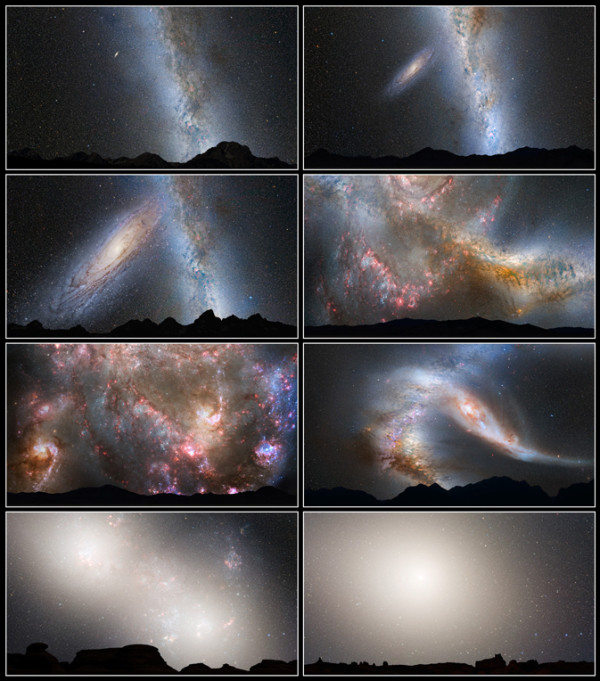
View larger. | This series of illustrations shows the predicted merger between our Milky Way galaxy and the neighboring Andromeda galaxy.
First row, left: Present day.
First row, right: In 2 billion years the disk of the approaching Andromeda galaxy is noticeably larger.
Second row, left: In 3.75 billion years Andromeda fills the field of view.
Second row, right: In 3.85 billion years the sky is ablaze with new star formation.
Third row, left: In 3.9 billion years, star formation continues.
Third row, right: In 4 billion years Andromeda is tidally stretched and the Milky Way becomes warped.
Fourth row, left: In 5.1 billion years the cores of the Milky Way and Andromeda appear as a pair of bright lobes.
Fourth row, right: In 7 billion years the merged galaxies form a huge elliptical galaxy, its bright core dominating the nighttime sky.
Image via NASA/ ESA/ Z. Levay and R. van der Marel, STScI/ T. Hallas/ A. Mellinger.
By the way, the Milky Way and Andromeda galaxies won’t be the only ones involved in this merger. As shown in the video below, the other large galaxy in our Local Group of galaxies – M33, aka the Triangulum galaxy – will also play a role.
In the video below, you’ll recognize the Triangulum galaxy as the smaller object near the Andromeda and Milky Way galaxies. Although the Triangulum galaxy likely won’t join the merger, it may at some point strike our Milky Way while engaged in a great cosmic dance with the two larger galaxies.
Across the universe, galaxies are colliding with each other. Astronomers observe galactic collisions – or their aftermaths – with the aid of powerful telescopes. In some ways, when a galactic merger takes place, the two galaxies are like ghosts; they simply pass through each other. That’s because stars inside galaxies are separated by such great distances. Thus the stars themselves typically don’t collide when galaxies merge.
That said, the stars in both the Andromeda galaxy and our Milky Way will be affected by the merger. The Andromeda galaxy contains about a trillion stars. The Milky Way has about 300 billion stars. Stars from both galaxies will be thrown into new orbits around the newly merged galactic center. For example, according to scientists involved in the 2012 studies:
It is likely the sun will be flung into a new region of our galaxy …
And yet, they said,
… our Earth and solar system are in no danger of being destroyed.
How about life on Earth? Will earthly life survive the merger? Astronomers say that the luminosity, or intrinsic brightness, of our sun is due to increase steadily over the next 4 billion years. As the sun’s luminosity increases, the amount of solar radiation reaching the Earth will also increase. It’s possible that – by 4 billion years from now – the increase in the Earth’s surface temperature will have caused a runaway greenhouse effect, perhaps similar to that going on now on the planet next door, Venus, whose surface is hot enough to melt lead. No one expects to find life on Venus (at least no one used to until very recently).
Likewise, it seems likely life on Earth will not exist 4 billion years from now.
What’s more, our sun is evolving, too. It’s expected to become a red giant star eventually. The sun’s outer layers will swell into the space of the solar system so that Earth itself is swallowed by the sun’s outer layers. That’s expected to happen about 7.5 billion years from now.
Perhaps by that time, some earthly inhabitants will have become space-faring. Perhaps we’ll have left Earth, and even our solar system. Do you think so? Let us know in the comments below.
Read more: Hubble Shows Milky Way is Destined for Head-On Collision

View larger. | Artist’s concept of a stage in the predicted merger between our Milky Way galaxy and the neighboring Andromeda galaxy, as it’ll unfold over the next several billion years. In this image, representing Earth’s night sky in 3.75 billion years, Andromeda (left) fills the field of view and begins to distort the Milky Way with tidal pull. Image via NASA/ ESA/ Z. Levay and R. van der Marel, STScI/ T. Hallas/ A. Mellinger.
Bottom line: Billions of years from now, our Milky Way galaxy and the Andromeda galaxy are expected to merge. New data show that the outer galaxy boundaries have likely already started colliding. This post contains photos and video illustrating the impending merger and showing how the Andromeda galaxy will appear in Earth’s night sky over the next 7 billion years.
The M31 Velocity Vector. I. Hubble Space Telescope Proper Motion Measurements
The M31 Velocity Vector. II. Radial Orbit Towards the Milky Way and Implied Local Group Mass
from EarthSky https://ift.tt/3h2E7MR


View larger. | Andromeda galaxy actual size? Yes. This image truly depicts what the night sky would look like if the Andromeda galaxy – the galaxy next door – were brighter. Original background shot of the moon by Stephen Rahn. Andromeda galaxy image via NASA. Composite photo by Tom Buckley-Houston. The composite showed up on Reddit a few years ago. Not convinced? Here’s a similar image via APOD.
The image above shows how the neighboring Andromeda galaxy occupies about the width of six moon-diameters on our sky’s dome. But, of course, the galaxy isn’t nearly this bright. You need a dark sky to see it, and, even then, it’s a barely visible fuzzy patch of light. In order to appear as bright as in the image above, the Andromeda galaxy would need to be closer. If it were close enough to look so bright, it would appear even bigger on our sky’s dome. And that’s going to happen someday! The Andromeda galaxy is currently racing toward our Milky Way at a speed of about 70 miles (110 km) per second. Ultimately, the two galaxies will collide and merge.
Normally, the news that the Milky Way and Andromeda are going to collide is not a very headline-causing piece of information, since it is due to take place in about 5 billion years. But, new research published in the peer-reviewed Astrophysical Journal in August this year reveals that the timeline has been revised: The collision has already started!

View larger. | Here’s another composite image showing the true size in our sky of the Andromeda galaxy. This one is from astrophotographers Adam Block and Tim Puckett. It was the Astronomy Picture of the Day for August 1, 2013.
That news about the Andromeda galaxy came from Project AMIGA, which uses the Hubble Space Telescope to look at the deep-space surroundings of the Andromeda galaxy. AMIGA stands for Absorption Map of Ionized Gas in Andromeda. NASA reported on this study earlier this year, calling it “the most comprehensive study of a halo surrounding a galaxy.”
The Andromeda galaxy, our Milky Way and other galaxies all sit enshrouded in a large envelope – a so-called galactic halo – which consists of gas, dust and stray stars. The halos of galaxies are faint, so faint that detecting them is not an easy feat. These astronomers measured the size of the halo of the Andromeda galaxy by looking at how light from background quasars had been absorbed by it. They were surprised to find that the Andromeda galaxy’s halo stretches much, much farther out beyond the visible boundaries of the galaxy than previously known.
In fact, it extends as far as half the distance to our Milky Way (1.3 million light-years) and even farther in other directions (up to 2 million light-years).
Does this mean the halos of the Andromeda and Milky Way galaxies are touching?
It turns out that, from our vantage point inside the Milky Way, we cannot easily measure the characteristics of our galaxy’s halo. However, because the two galaxies are so similar in size and appearance, scientists assume that the halo of the Milky Way would also be similar.
In other words, it’s the faint halos of the galaxies that indeed appear to have started to touch one another. Thus, in a manner of speaking, the collision between our two galaxies has already started.

Observing 43 background quasars, scientists used the Hubble Space Telescope to map out the halo of the closest spiral galaxy to our Milky Way, the Andromeda galaxy. The light from these very distant quasars (emission from very bright galaxies fueled by a central supermassive black hole) is absorbed as it travels through the halo, and by studying the change in absorption depending on where in the halo you look, scientists not only see the large extent of the halo but also what it consists of. Illustration via NASA/ ESA/ E. Wheatley (Space Telescope Science Institute)

This illustration depicts what the Andromeda galaxy’s gaseous halo might look like if it were visible to humans on Earth. At 3 times the size of the Big Dipper, the halo would be easily the biggest feature on the nighttime sky, according to NASA. Recent measurements of the halo show that the collision between the Milky Way and Andromeda galaxies has already begun. Image via NASA/ ESA/ J. DePasquale and E. Wheatley (STScI)/ Z. Levay.
Not taking the halo in account, the bulk of the Andromeda galaxy is now about 2.5 million light-years away from us, and getting closer all the time. As stated above, as the Andromeda galaxy comes closer, it will appear larger in our sky.
Between now and the eventual merger, any beings alive on Earth will see it get bigger and bigger and BIGGER in our night sky.
The artist’s concepts below, released by NASA in 2012, show what will happen to Earth’s night sky as the Andromeda galaxy hurtles toward us.
The descriptions below are based on painstaking Hubble Space Telescope measurements of the motion of the Andromeda galaxy, followed by computer modeling of the inevitable future collision between the two galaxies. A series of studies published in 2012 showed that – rather than glancing off each other, as merging galaxies sometimes do – our Milky Way galaxy and the Andromeda galaxy will in fact merge to form a single big elliptical, or football-shaped, galaxy.

View larger. | This series of illustrations shows the predicted merger between our Milky Way galaxy and the neighboring Andromeda galaxy.
First row, left: Present day.
First row, right: In 2 billion years the disk of the approaching Andromeda galaxy is noticeably larger.
Second row, left: In 3.75 billion years Andromeda fills the field of view.
Second row, right: In 3.85 billion years the sky is ablaze with new star formation.
Third row, left: In 3.9 billion years, star formation continues.
Third row, right: In 4 billion years Andromeda is tidally stretched and the Milky Way becomes warped.
Fourth row, left: In 5.1 billion years the cores of the Milky Way and Andromeda appear as a pair of bright lobes.
Fourth row, right: In 7 billion years the merged galaxies form a huge elliptical galaxy, its bright core dominating the nighttime sky.
Image via NASA/ ESA/ Z. Levay and R. van der Marel, STScI/ T. Hallas/ A. Mellinger.
By the way, the Milky Way and Andromeda galaxies won’t be the only ones involved in this merger. As shown in the video below, the other large galaxy in our Local Group of galaxies – M33, aka the Triangulum galaxy – will also play a role.
In the video below, you’ll recognize the Triangulum galaxy as the smaller object near the Andromeda and Milky Way galaxies. Although the Triangulum galaxy likely won’t join the merger, it may at some point strike our Milky Way while engaged in a great cosmic dance with the two larger galaxies.
Across the universe, galaxies are colliding with each other. Astronomers observe galactic collisions – or their aftermaths – with the aid of powerful telescopes. In some ways, when a galactic merger takes place, the two galaxies are like ghosts; they simply pass through each other. That’s because stars inside galaxies are separated by such great distances. Thus the stars themselves typically don’t collide when galaxies merge.
That said, the stars in both the Andromeda galaxy and our Milky Way will be affected by the merger. The Andromeda galaxy contains about a trillion stars. The Milky Way has about 300 billion stars. Stars from both galaxies will be thrown into new orbits around the newly merged galactic center. For example, according to scientists involved in the 2012 studies:
It is likely the sun will be flung into a new region of our galaxy …
And yet, they said,
… our Earth and solar system are in no danger of being destroyed.
How about life on Earth? Will earthly life survive the merger? Astronomers say that the luminosity, or intrinsic brightness, of our sun is due to increase steadily over the next 4 billion years. As the sun’s luminosity increases, the amount of solar radiation reaching the Earth will also increase. It’s possible that – by 4 billion years from now – the increase in the Earth’s surface temperature will have caused a runaway greenhouse effect, perhaps similar to that going on now on the planet next door, Venus, whose surface is hot enough to melt lead. No one expects to find life on Venus (at least no one used to until very recently).
Likewise, it seems likely life on Earth will not exist 4 billion years from now.
What’s more, our sun is evolving, too. It’s expected to become a red giant star eventually. The sun’s outer layers will swell into the space of the solar system so that Earth itself is swallowed by the sun’s outer layers. That’s expected to happen about 7.5 billion years from now.
Perhaps by that time, some earthly inhabitants will have become space-faring. Perhaps we’ll have left Earth, and even our solar system. Do you think so? Let us know in the comments below.
Read more: Hubble Shows Milky Way is Destined for Head-On Collision

View larger. | Artist’s concept of a stage in the predicted merger between our Milky Way galaxy and the neighboring Andromeda galaxy, as it’ll unfold over the next several billion years. In this image, representing Earth’s night sky in 3.75 billion years, Andromeda (left) fills the field of view and begins to distort the Milky Way with tidal pull. Image via NASA/ ESA/ Z. Levay and R. van der Marel, STScI/ T. Hallas/ A. Mellinger.
Bottom line: Billions of years from now, our Milky Way galaxy and the Andromeda galaxy are expected to merge. New data show that the outer galaxy boundaries have likely already started colliding. This post contains photos and video illustrating the impending merger and showing how the Andromeda galaxy will appear in Earth’s night sky over the next 7 billion years.
The M31 Velocity Vector. I. Hubble Space Telescope Proper Motion Measurements
The M31 Velocity Vector. II. Radial Orbit Towards the Milky Way and Implied Local Group Mass
from EarthSky https://ift.tt/3h2E7MR

Aucun commentaire:
Enregistrer un commentaire